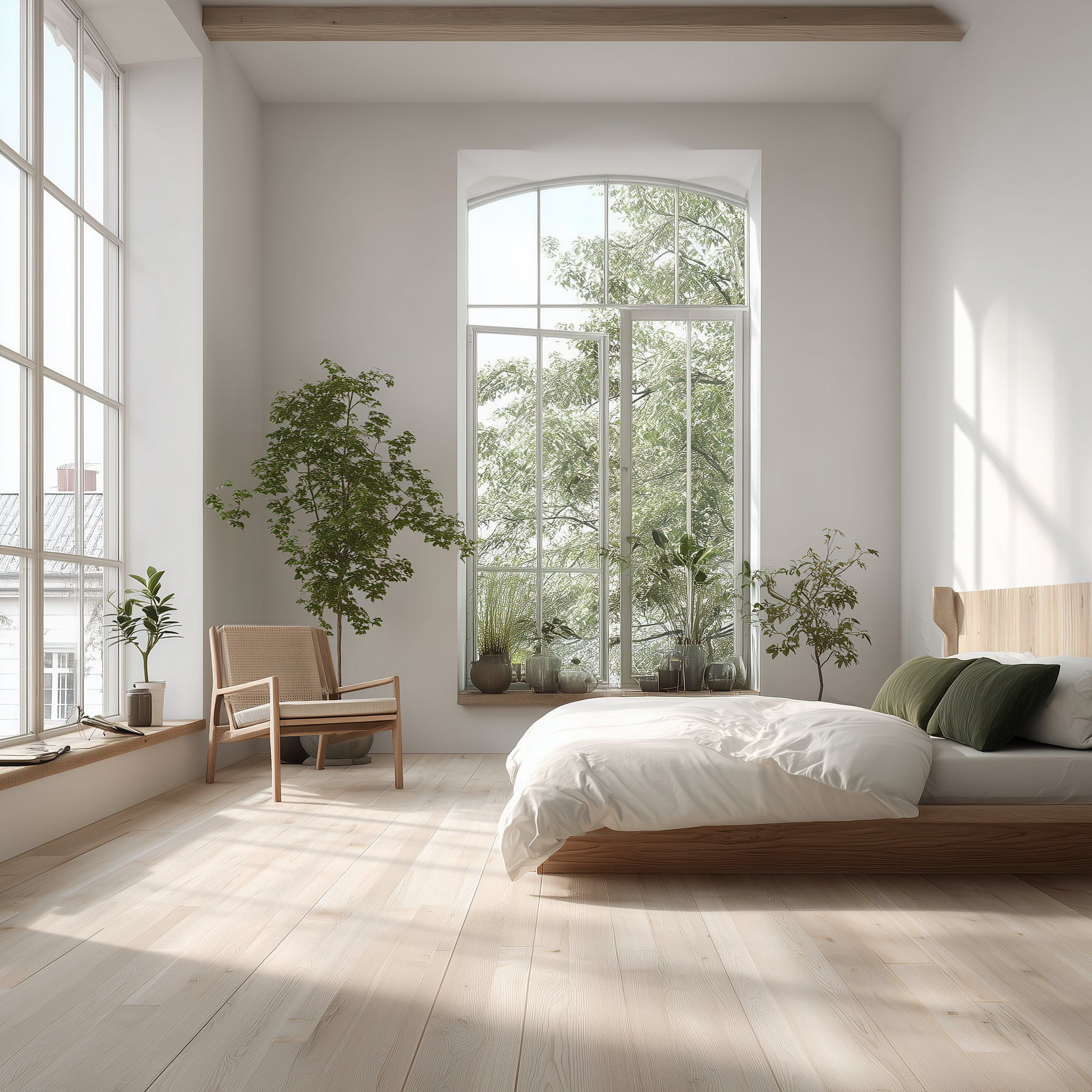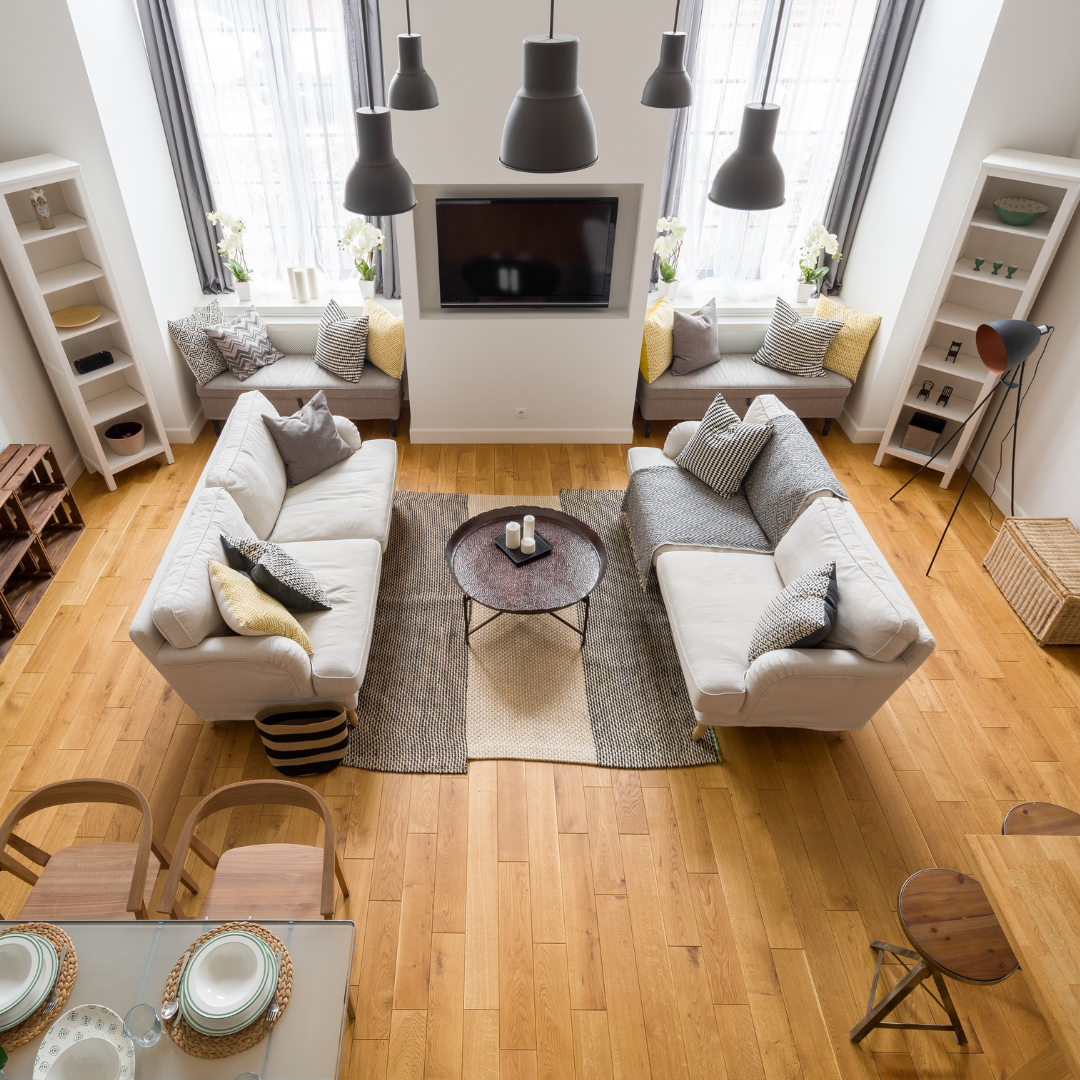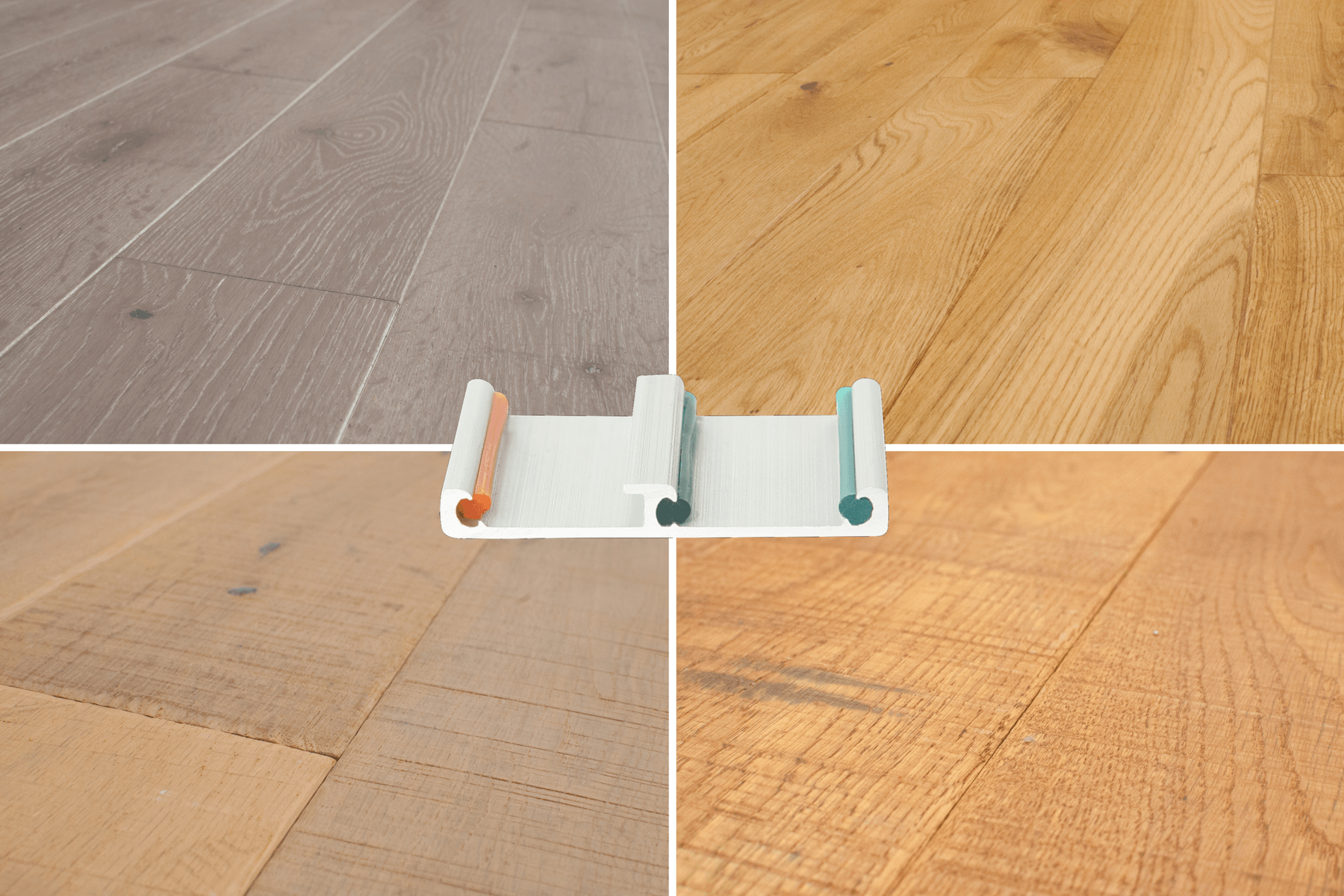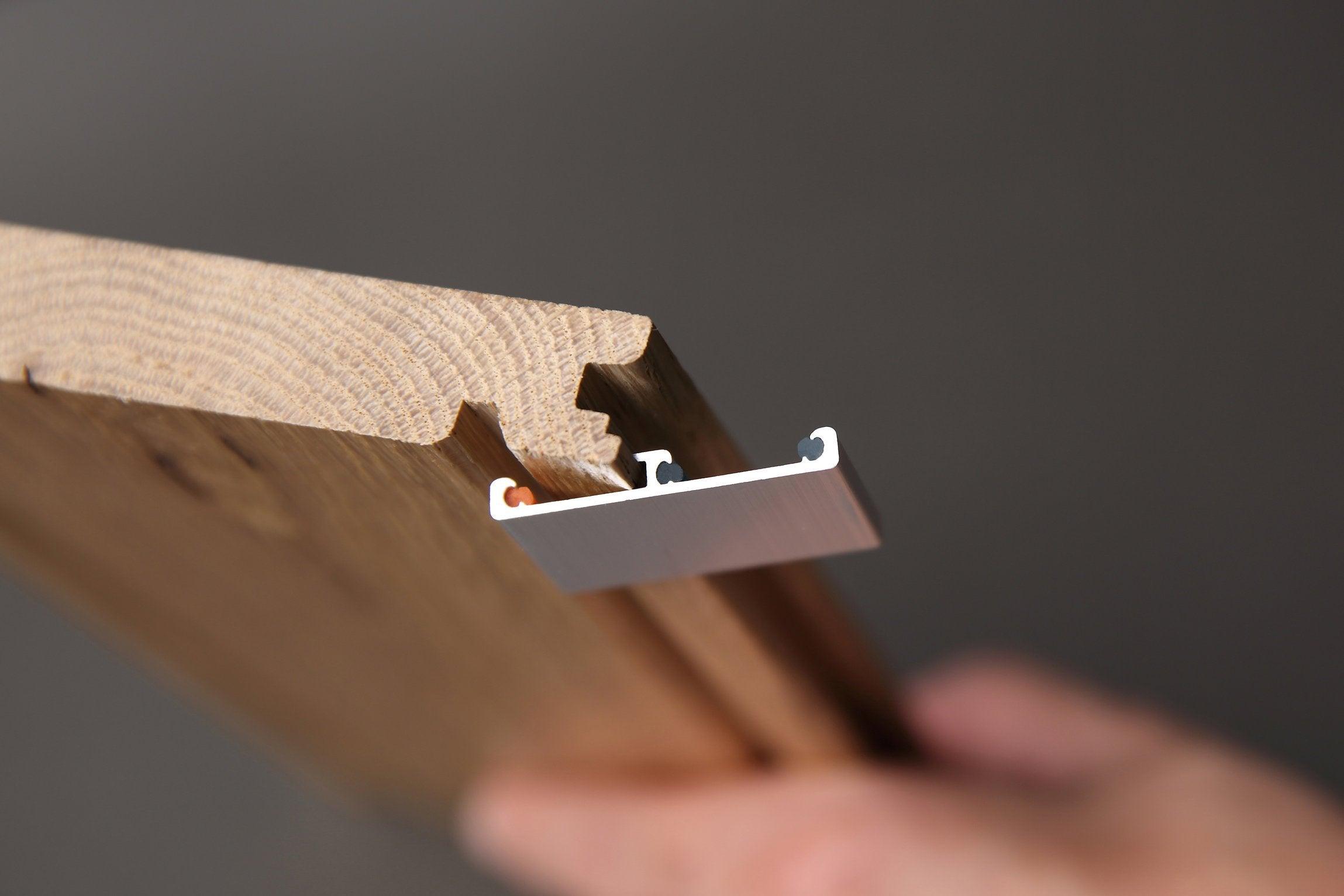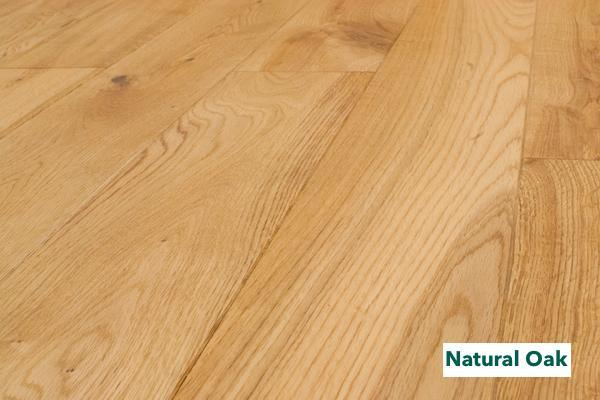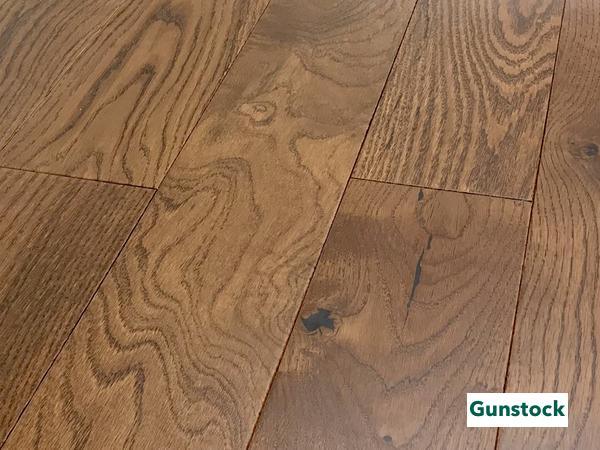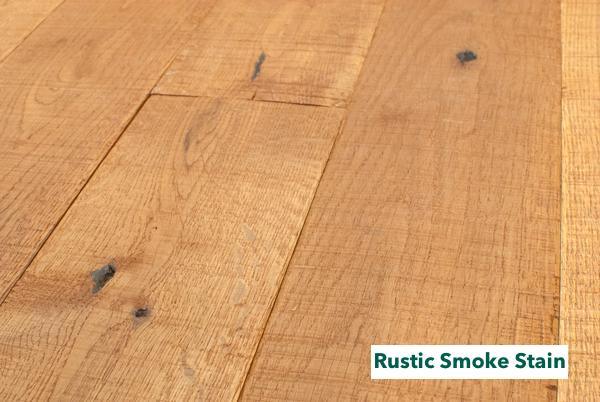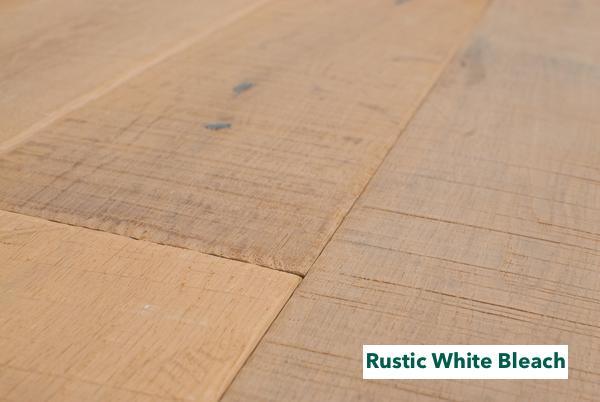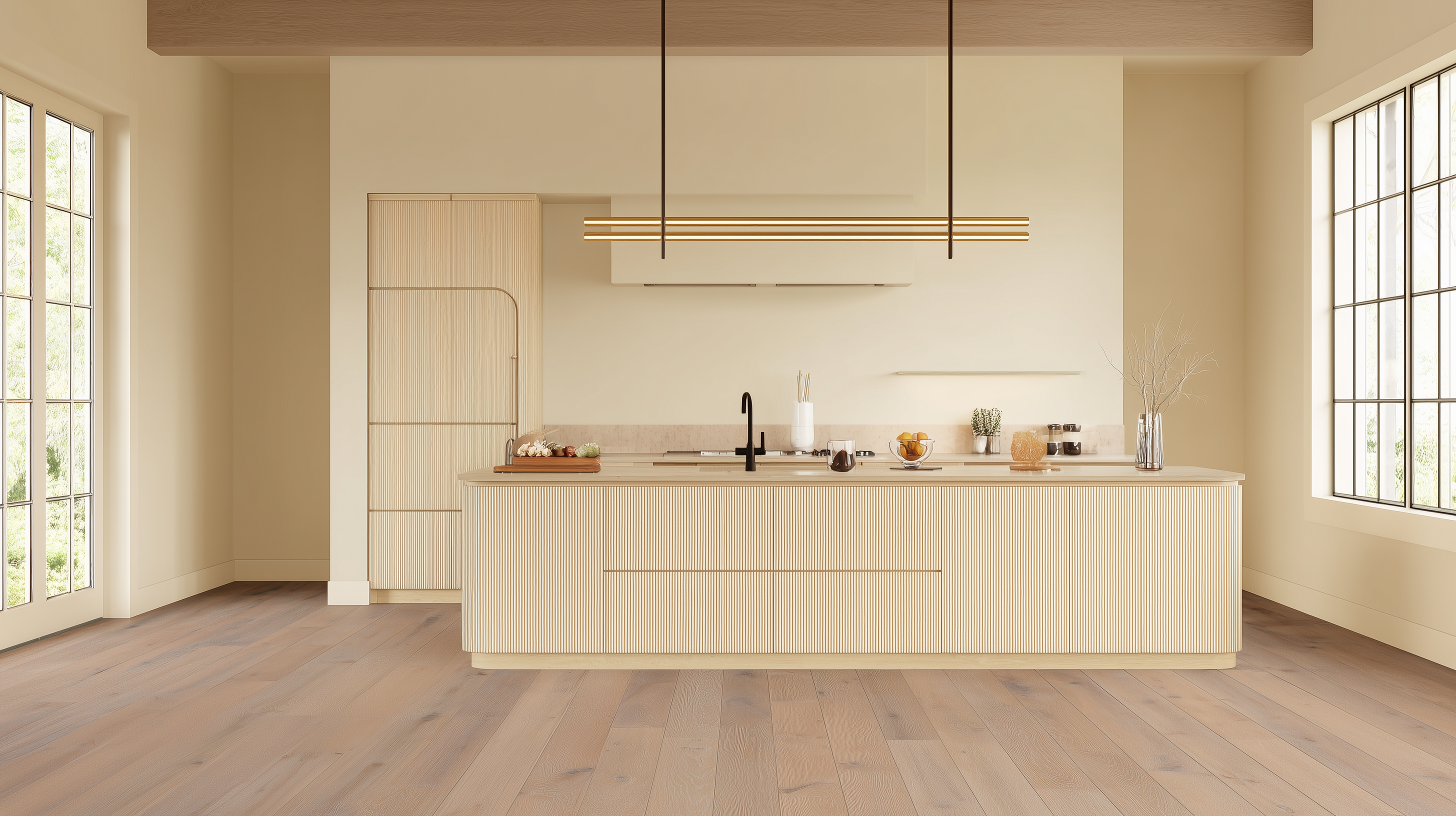Wood grain is more than a design detail, it’s the soul of your hardwood floor. Whether bold and rustic or refined and contemporary, each plank tells a story shaped by the saw. Understanding white oak flooring cuts—rift, quarter, plain, and live sawn—can dramatically influence your floor’s look, longevity, and personality.
In this guide, we’ll decode everything you need to know about wood grain and board cuts so you can choose flooring that feels right underfoot and looks even better over time.

What Shapes the Grain? Nature, Stress, and the Saw
Wood grain isn’t just a random pattern—it’s a fingerprint of the tree’s history. Everything from the species to its growing conditions and how the mill slices it up determines the final look. Grain direction is the secret sauce. It decides whether your floor has sleek, straight lines or wild, unpredictable waves. Medullary rays (those flashy streaks in oak) and pore size add texture and character, making some floors look smooth while others scream rustic charm. Oak is the show-off of the wood world, with dramatic rays and bold textures. Other species? More subtle, more understated. Understanding these factors means you can pick a floor that doesn’t just look good—it fits your style and lasts for years.
Ever walked into a room and noticed how some oak floors look crisp and straight while others are a swirling masterpiece? There’s a reason for that. It’s not magic—it’s how the sawmill slices the log. Trees with a tough life—wind, stress, weird growth patterns—end up with curly, mesmerizing grains that make your floor a conversation starter. At the end of the day, the mill’s cutting technique is what shapes the final masterpiece beneath your feet.
Different cutting styles mean different looks—some classic, some totally unique. Now, let’s break down how each cut transforms raw wood into stunning flooring.
Regardless of species, all logs go through the same process, and each type of cut yields the same look. Therefore, today, we will refer to only white oak.
The type of cuts used to make the planks affects the lumber’s clarity, graining, price, and grading. So let’s start by looking at the different ways lumber mills cut up the logs.
The Big Three: Rift, Quarter, and Plain Sawn Explained
There are primarily three white oak flooring cuts that you'll see at your local flooring store. They are flat, quarter-sawn, and rift cut.
1. Flat Sawn
Flat sawn or plain sawn is the most common and least expensive method of sawing lumber for flooring. However, as the saw blade reaches the beginning of the heartwood, the log turns 90-degrees, and the mill continues cutting. After they cut all four sides, they finish by cutting boards out of the heartwood.
It is a more efficient milling method than a quarter or rift sawing. However, they don't use the heartwood for flooring material which generates more waste. These boards are strong, yet they are the most likely to have issues like warping, twisting, and cupping.

2. Quarter Sawn
Quarter sawn lumber, as the name implies, starts by cutting the entire log into quarters. Then, the mill cuts a board from one flat surface, rotates the log, and cuts the next board, alternating as they cut. As a result, they end up with ever narrower boards until only a wedge piece is left.
Quarter-sawing yields stronger boards than plain sawn, but the higher waste adds to its cost.
This promotional video does an excellent job of demonstrating the difference between quarter and plain sawing.

3. Rift Sawn White Oak Flooring
Rift sawn white oak lumber, like quarter sawn, starts by cutting the log into quarters. The difference here is that the mill cuts each quarter into a spiral pattern. Visualize the end of a log and the circular rings like a clock face. Rift cut boards come out of sections at the 2, 4, 8, and 10 o'clock positions. When viewing the end of the board, the grain pattern runs between 30 to 60 degrees from the face, with 45 degrees the optimal cut.
Rift cut lumber is difficult to make and creates the most waste. However, the boards are the most uniform, have the straightest grains, and have the most resistance to warping or cupping.
This animation demonstrates how the rift-cut boards emerge from the log. It's like cutting a pie into slices, except the process does not use the center wood core.


Live Sawn: A Heritage Cut with Rustic Appeal
Among all white oak flooring cuts, live sawn delivers the most rustic character because it shows the full range of the tree’s grain. Before there were electrical or steam-powered saws, good old-fashioned two-man saws and muscle turned trees into boards.
Live sawn was the only way pioneers could cut boards to make their homes and barns. They cut boards from logs by slicing them lengthwise, and hopefully, kept each board the same width. Lumber mills are recreating the look again due to increasing demand for rustic or old-timey look of barn wood and wide planks.

The technique is called Live Sawn. Other terms for this cut are French cut or European cut. It's the simplest way to cut a log. A lumber mill will place the tree on their saw and cut slices down the length of the tree without turning it. It's like slicing a loaf of bread lengthwise to get long, uniform slices. These planks provide a full range of the tree's characteristics and grades of lumber all in one board. The center cuts will show a cross-section of the entire tree with the darker heartwood and cathedral grain patterns in the middle to the tight grains of the outer sapwood.
Live sawn is the only method that includes the heartwood. Typically, lumber mills discard heartwood and use it as pallet-grade lumber.
Why White Oak Is the Gold Standard
White oak flooring isn’t just about looks—it’s about durability, stability, and timeless appeal. This wood is tough, resists wear, and stands up to high traffic, making it a favorite for busy households. One of its signature traits is its grain. White oak delivers a mix of straight, clean lines and unique, natural variations. It has medullary rays—those striking, tiger-stripe patterns—that give it an upscale, distinguished appearance. Thanks to its tight grain and dense structure, white oak naturally resists moisture better than many other hardwoods. That’s why it’s often used in kitchens, entryways, and even wine barrels. Depending on how it’s cut, white oak can take on different personalities.
Quarter sawn offers refined elegance with its straight grain and signature flecks, while plain sawn has a more natural, flowing look. Whether you want a sleek modern feel or a warm, traditional ambiance, white oak adapts beautifully to any style. Bottom line: If you want a floor that’s strong, stylish, and built to last, white oak delivers. By doing so, you can make an informed decision that meets your needs and enhances the beauty of your space. Depending on the cut, white oak flooring cuts offer everything from refined elegance to warm rustic charm.
Reading the Grain: White Oak’s Signature Looks
White oak has a unique grain that lends itself to a variety of different looks. Depending on the type of cut, oak can look like an entirely different species.
Flat Sawn White Oak Boards
The rings that intersect the board are no more than 35 degrees from the top plain of the board. The grains resemble dark cathedral or flame shapes and designs.
Flat sawn planks yield an irregular grain pattern depending on where the board came from inside the log. For example, a board near the outside of the log looks like quarter sawn, while planks from the center have a curved or cathedral grain pattern.

Quarter Sawn White Oak
Quarter sawn boards have more consistent graining because the growth rings run parallel to the larger faces of the board. However, the grains on the long edge of the board may still be inconsistent and not parallel.
With this cut, the growth rings are at 90 degrees to the face of the board. Because the cuts are not across the grain as in flat sawn, the board's face has straighter graining. This cut produces white oak's signature “tiger stripes” called medullary rays. In the living tree, medullary rays carried nutrients within the tree. They can be very wide and pronounced or thin and subtle.


Rift Sawn
Rift sawn yields boards of the highest quality and clarity. Each board is nearly flawless, with arrow-straight lines unmarred by tiger stripes, knots, or color variations.

What Grain Says About Your Style
Not all wood grains are created equal, and the one you choose will define the entire look and feel of your space. Some grains offer a sleek, modern aesthetic, while others bring out the cozy, rustic charm of a cabin retreat.
If you love clean lines and uniformity, rift-sawn wood is the way to go. Its straight grain gives off an elegant, minimalist vibe—perfect for contemporary homes. Quarter-sawn wood, on the other hand, offers striking medullary rays and increased stability, making it a top choice for those who want a mix of durability and visual appeal.
Looking for warmth and character? Plain-sawn wood gives you bold grain patterns and a more natural feel, making it ideal for traditional or farmhouse-style spaces. Want the best of all worlds? Live-sawn boards capture every element of the tree, blending different grain types in a single board for a unique, all-encompassing look.
By choosing the right grain pattern, you’re not just picking a floor—you’re setting the tone for the entire room. Get it right, and you’ll have a floor that looks incredible and lasts for decades.
Cut, Grade, Cost: What Really Drives the Price
Not all white oak flooring cuts are priced the same, since each method creates different waste, stability, and appearance. Not all wood flooring is created equal, and if you've ever wondered why one plank costs significantly more than another, you're not alone. The price of wood flooring isn’t just about the species—it’s about how the wood is cut, graded, and processed. The way a log is sliced can affect everything from stability to visual appeal, and those differences show up in the price tag.
Before we talk about price, let's clear up a big misconception—grading isn't about quality. It's about appearance. The National Wood Flooring Association (NWFA) defines different cuts based on grain characteristics.
-
Quarter Sawn – At least 50% of the board features quartered characteristics, meaning grain lines are tight and mostly parallel, with those striking medullary ray flecks wider than 1/16".
-
Rift Sawn – At least 75% of the board must display rift characteristics, meaning tight, straight grain lines with minimal medullary rays.
-
Rift & Quartered – A mix of both cuts, offering stability, clean grain, and a visually appealing blend.
-
Live Sawn – Sometimes called French cut, this method incorporates all grain characteristics in a single board for a unique, all-in-one look.
-
Plain Sawn – The most common and budget-friendly option, showing a mix of flowing, wavy grain patterns.
Beyond cuts, grading also plays a role in price:
-
Select Grade – Clean, uniform boards with minimal knots or color variations.
-
#1 Common – More variation, occasional knots, and a mix of light and dark tones.
-
#2 Common (Rustic or Builder’s Grade) – Full of personality, featuring knots, color variations, and bolder grain patterns.
Now, let’s talk cost. Plain sawn white oak is the most affordable option, while quarter sawn costs more due to extra milling and waste. Rift sawn? That’s the premium cut—high waste, high labor, and high demand make it the most expensive. Expect to pay about a dollar more per square foot as you move up the ladder from plain sawn to rift and quartered.
If you’re after a top-tier, dimensionally stable, and visually refined look, rift sawn is worth the investment. But if you love a bit of natural variation and warmth, plain or live sawn might be the perfect fit for your space.
Finding the Right Grain for Your Lifestyle
When selecting the right wood grain for your flooring, consider the style and functionality you want to achieve. Think about the level of traffic the area will receive and the desired level of maintenance. For high-traffic areas, you might prefer the durability of quarter-sawn or rift-sawn wood. If you’re aiming for a rustic look, plain-sawn wood with its varied grain patterns might be the best choice. Additionally, consider the color and texture of the wood, as well as the grain pattern. Different wood species offer unique benefits and characteristics, so take the time to research and understand your options. By doing so, you can make an informed decision that meets your needs and enhances the beauty of your space.
Texture, Tone & Flow: How Grain Impacts Design
When it comes to white oak flooring cuts, it determines more than just how the board performs—it influences the overall aesthetic, texture, and feel underfoot. Whether you’re after precision or personality, understanding grain is key to choosing the right hardwood.
Common Grain Types and What They Look Like
Woodcutters create different wood grain patterns by slicing logs at specific angles. This produces styles like:
-
Flat grain – flowing, wavy lines
-
Vertical grain – tight, parallel lines
-
Spiral grain – dynamic curves from twisted growth
-
Granular patterns – bold, varied markings
These variations affect not only how the floor looks, but how it wears over time.
Natural Beauty & Species Differences
Hardwood trees all grow differently. The way the tree trunk forms and how the tree develops can reveal stunning natural characteristics and unique patterns in the final plank. Some boards will highlight:
-
Natural imperfections like knots and swirls
-
Natural features like medullary rays or large pores
-
Subtle wood fibres and smooth textures
Each species—whether red oak or white oak planks—brings its own signature character.
Choosing the Right Look for Your Space
Want clean and contemporary? Go for straight grained planks, vertical cuttings, or engineered boards that highlight three dimensional effect and modern aesthetics. Prefer that farmhouse vibe? A mix of textures adds rustic charm and warmth to any rustic home.
For those who love more textures, some people even prefer flooring that’s left natural to highlight its raw, untouched charm.
What is the Best Cut for Oak Flooring?
Each type of cut creates boards of unique character. For example, flat sawn oak makes boards with that distinctive significant flame or cathedral grain pattern on the surface. However, since the grains go in different directions, these boards can expand and contract more. As a result, it's more prone to warping, cupping, and twisting than other cuts with straighter grain patterns.

(Flat sawn white oak boards)
Quarter sawn oak doesn't show the big cathedral grains of flat sawn, and it's less likely to warp. However, it displays straight, even grains highlighted with the rays or tiger stripes desirable in oak flooring

(Quarter sawn white oak boards)
Rift sawn oak is the best choice if you want a floor that's entirely free of dark or uneven grains. On the other hand, it can look monotonous across a large floor, so most people like the look of a mixture of rift and quarter sawn.

(Rift sawn white oak boards)
Easiklip is a mixture of plain sawn, rift sawn, and quarter sawn oak flooring in 5-inch wide, prefinished planks. It's an excellent choice for DIYers and anyone who wants a moderately priced solid white oak floor. It comes in five colors. You can see them and order samples here
(An Easiklip solid 3/4" solid white oak floor, mixture of plain sawn, rift sawn and quarter sawn.)
Your Floor’s Fingerprint: Choose with Confidence
Your floor isn't just a surface you walk on—it’s a statement. The grain pattern you choose determines how it will look, how it will perform, and how long it will last. Whether you go for the classic elegance of quarter sawn, the uniform precision of rift sawn, or the rustic charm of plain sawn, make sure it aligns with your vision and lifestyle.
Now that you know the difference, don’t settle for just any flooring. Choose a wood grain that enhances your home’s style and stands the test of time. Understanding the different white oak flooring cuts helps you choose a floor that not only looks incredible but also lasts for decades
If you’re ready to upgrade your space with premium white oak flooring, check out EasiKlip’s selection of expertly crafted, high-quality hardwood floors today!
